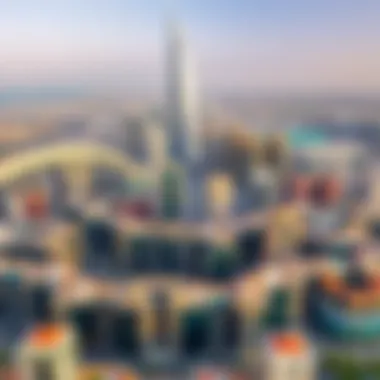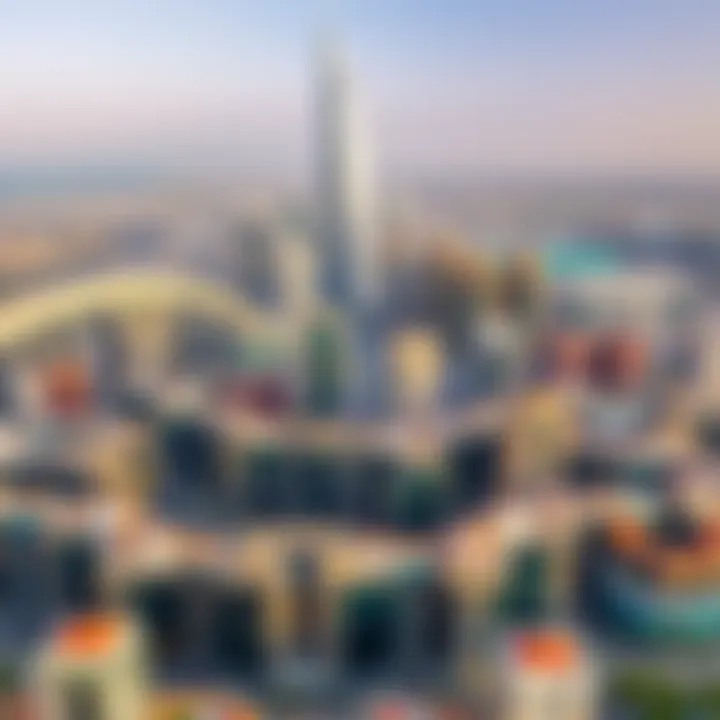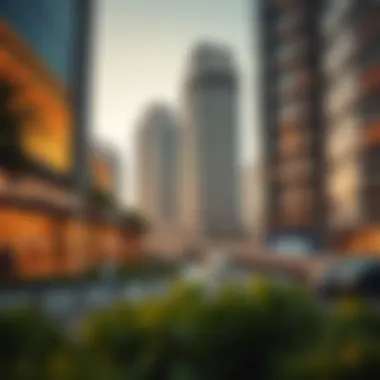City Centre Dynamics: Understanding Urban Hubs in Dubai


Market Insights
When considering the urban landscape of Dubai, the city centre stands as a testament to the evolving dynamics of urban life. In the heart of this thriving metropolis, real estate trends reflect broader economic factors, societal shifts, and increasing cultural diversity. This vibrant hub is not only a physical space but also a microcosm of the complex interplay of life, commerce, and culture.
Current Trends in Dubai Real Estate
In recent years, Dubai's real estate has seen a whirlwind of activity, largely fueled by both local and foreign investment. One of the noticeable trends is a growing demand for mixed-use developments. Such properties are designed to cater to the need for residential spaces while also providing commercial facilities. Communities like Dubai Marina and Downtown Dubai exemplify this trend. They blend living, working, and recreational spaces seamlessly, appealing especially to expatriates and young professionals looking for convenience.
Historically, the allure of Dubai has been its promise of luxury and modernity. However, in tandem with luxury offerings, there's been an increasing focus on affordability. Developers are launching initiatives to build more budget-friendly housing. This shift could cater to a wider demographic, from young families to rising professionals seeking their first home.
Price Fluctuations and Forecasts
The property market in Dubai is also characterized by its inherent volatility. Prices can swing like a pendulum due to various factors including governmental policies and global economic conditions. As of late 2023, there has been a rise in property prices, attributed largely to the easing of travel restrictions and a resurgence in tourism. Investors are observing this trend keenly; reports suggest a forecasted price increase of around 5-7% across various segments in the next year, making it a key moment for potential buyers and investors to dive in.
"The future of urban living in Dubai hinges on the city's ability to blend tradition with modernity, ensuring its centre remains a vibrant place for all."
Property Buying Guides
For individuals looking to establish roots in this bustling urban milieu, navigating the real estate market can seem like trying to find a needle in a haystack. However, with the right guidance and knowledge, the process can be simplified significantly.
Steps to Buy Property in Dubai
- Research and Consider Your Needs
- Engage a Reputable Real Estate Agent
- Arrange Financing
- Finalizing the Purchase
- Identify your preferred location based on lifestyle preferences and commuting requirements.
- Decide on property type—whether it be an apartment, villa, or commercial space.
- Collaborating with a knowledgeable realtor can provide insights into the current market and help you make informed decisions.
- If you're not buying outright, securing a mortgage pre-approval can streamline the buying process significantly. Several banks and financial institutions in Dubai offer various home loan options for expatriates and citizens alike.
- Once you’ve zeroed in on a property, navigating through legal procedures with your agent’s help will smoothen the transaction.
Legal Considerations for Buyers
Purchasing property in Dubai requires careful attention to legal details. Foreign buyers have a particular interest in knowing the limits of property ownership. Here are some legal considerations worth noting:
- Freehold vs Leasehold: Understand the difference between freehold properties (which allow full ownership) and leasehold properties (which provide ownership for a specified term).
- Regulatory Framework: The Dubai Land Department governs property transactions, so familiarity with laws and regulations is essential.
- Registration Fees: Buyers should budget for registration fees, which typically run around 4% of the property's purchase price.
Understanding these nuances will not only assist in navigation but also it is crucial for making investments sound and secure. As the city continues to change, staying informed about these aspects will contribute greatly to ensuring a fruitful investment in Dubai's dynamic heart.
Defining the City Centre
Understanding what constitutes a city centre is crucial when exploring urban dynamics, especially in places like Dubai, where the city centre embodies a unique blend of modernity and tradition. The city centre serves as the heartbeat of urban life, encapsulating the economic, cultural, and social activities that define a metropolis. It is not merely a geographical location, but rather a hub where various elements intersect—business, leisure, and cultural experiences—all woven together to create a vibrant urban tapestry.
Defining the city centre goes beyond just its physical boundaries. It delves into the historical and social layers that have shaped the area into what it is today. As demographics shift and technology evolves, so too does the identity of a city centre. By examining its essence, one can appreciate the vitality and the challenges that urban areas face.
Historical Context
The historical context of city centres provides valuable insights into their evolution over time. The concept of a city centre has ancient roots, stemming from market squares or central places where trade and community interactions flourished. These areas served as focal points for commerce and social gathering, setting the stage for what we recognize today as bustling urban centres.
In the case of Dubai, the city centre’s transformation from a small trading post into a global business hub illustrates this evolution vividly. The early settlement along Dubai Creek marked the genesis of urban life in the region. Over the decades, it evolved, influenced by waves of migration and globalization, resulting in a rich cultural mosaic that contributes to the city’s allure. This layered history informs the character of the city centre today, making it an essential consideration for anyone looking to understand modern urban dynamics.
Characteristics of a City Centre
City centres are typically marked by a distinct set of characteristics that set them apart from other areas in a metropolis. Here are some notable aspects:
- High Density: City centres often feature a high concentration of businesses, offices, and amenities. This density fosters a vibrant atmosphere, creating opportunities for interactions that might not occur in less populated areas.
- Accessibility: They usually have strong transportation links, making it easy for residents and visitors to navigate the urban landscape. Public transport systems, pedestrian-friendly pathways, and cycling options are key components.
- Diverse Offerings: Beyond commerce, city centres are often cultural hotspots. Museums, galleries, theaters, and various dining options reflect the diverse lifestyles of those who inhabit the area. This variety enhances the overall experience for those living or working in the vicinity.
- Economic Activity: The city centre is the economic engine of urban areas, housing major companies, retail outlets, and startups. This concentration of job opportunities attracts people from surrounding regions, further fueling growth.
City Centre vs. Suburban Areas
The contrast between city centres and suburban areas is striking and nuances the discussion of urban dynamics. Suburban areas, with their quiet neighborhoods and spacious homes, often appeal to families seeking a slower pace of life. In contrast, the city centre is characterized by excitement and energy, drawing those who thrive in a dynamic environment.
Key Differences:
- Lifestyle: City centres often offer a lively, fast-paced lifestyle, whereas suburban areas lean towards tranquility and space.
- Real Estate: Property prices vary significantly; city centre real estate often boasts higher prices due to demand, while suburban homes may offer larger spaces for a lower cost.
- Community: Social interactions can differ dramatically—city centres promote diverse, transient communities, while suburbs tend to cultivate long-standing neighborhood bonds.
- Infrastructure: Downtowns typically feature advanced infrastructure with a focus on public transport, while suburban areas might emphasize car travel.
By recognizing these distinctions, investors, homebuyers, realtors, and developers can make informed decisions about navigating the complexities of urban living and capitalize on the unique offerings of each environment.
"City centres are not just geographical locations; they are integral to understanding the cultural and economic landscape of a region."
A well-rounded grasp of city centres allows investors and stakeholders to leverage market trends, anticipate shifts, and respond effectively to the vibrant dynamics that define urban life.
Economic Factors Influencing City Centres


Economic elements play a pivotal role in shaping city centres. It’s not just the skyline or the hustle and bustle that draws people in; it’s the underlying economic dynamics that can often dictate the rhythm of urban life. Understanding how these factors influence and shape city centres can provide invaluable insights, especially for investors, homebuyers, realtors, expatriates, and developers who are navigating this intricate landscape.
Commercial Real Estate Trends
Within city centres, commercial real estate is the backbone of economic activity. The demand for office space in urban areas often reflects the overall economic health. More businesses migrating to centralized locations means more high-rise offices popping up. Recently, there's been a noticeable trend towards flexible workspaces and co-working environments, recognizing modern worker preferences. Research indicates that companies want to attract and retain talent, and location plays a significant role. Areas with robust infrastructure and accessibility see higher demand.
Moreover, city centres are adapting to changing consumer needs. Retail trends are evolving, with a push towards experiential shopping rather than mere transactions. Mixed-use developments that blend residential, commercial, and leisure spaces are rapidly gaining popularity. This approach not only maximizes land use but also creates a vibrant atmosphere that encourages foot traffic, stimulating local economies.
Impact of Tourism
Tourism injects significant revenue into city centres, making it a key economic factor. In destinations like Dubai, experiences tailor-made for tourists often become integral to the local economy. Tourists flock to iconic landmarks, bazaars, and entertainment venues, which in turn boosts local business. According to some estimates, the tourism sector can account for over 10% of a city’s GDP.
Interestingly, the shift in tourism patterns is something to note. Visitors are no longer just looking for sights; they crave authentic experiences. This has led to a rise in boutique hotels and local tours focusing on community interaction. City centres must therefore leverage this trend by ensuring they maintain a balance between attracting tourists and providing quality experiences for local residents as well.
Local Business Ecosystem
The ecosystem surrounding local businesses in city centres is unique and often highly advantageous. When small businesses thrive, they foster a sense of community and contribute to a city’s economic vibrancy. In essence, these businesses often form the heart of urban life. There’s a richness to the interactions and connections between local shops, artisans, and services that chain stores simply cannot replicate.
Additionally, local businesses often innovate and adapt to the needs of the community, which can lead to distinct products and services that cater specifically to urban dwellers. City centres can become breeding grounds for creativity and entrepreneurship, enhancing their appeal. Government initiatives, such as grants or support programs for startups, further stimulate this environment. As these businesses flourish, they can create job opportunities and enhance the economic fabric of the city.
City centres are indeed a melting pot of economic dynamics, where commerce, tourism, and local businesses intertwine in complex ways. Understanding these influences equips stakeholders with the knowledge necessary to make informed decisions that will impact the urban landscape in meaningful ways.
Social Dynamics Within City Centres
City centres are far more than mere geographical locations; they serve as vibrant ecosystems where diverse social dynamics unfold. Understanding these dynamics is essential, especially in a bustling urban environment like Dubai, where the convergence of cultures and lifestyles creates a unique fabric of community life. The interactions that occur within these areas not only enhance the richness of urban living but also impact economic activities and community engagements significantly.
Cultural Diversity and Community Life
In modern city centres, particularly in cosmopolitan hubs like Dubai, cultural diversity is a defining characteristic. People from various backgrounds come together, forming a melting pot of traditions, practices, and cuisines. This blend fosters a sense of community and inclusivity that can be particularly appealing to both residents and visitors.
Benefits of Cultural Diversity:
- Enhanced Creativity: With different perspectives and experiences, there tends to be a surge in creativity. This is visible in the arts, culinary scene, and local businesses that cater to a wide range of tastes and preferences.
- Global Connections: Interactions among cultures can lead to global relationships. Local businesses benefit from international clientele, reinforcing the economic framework of the city centre.
- Cultural Events: Festivals and cultural celebrations from various communities are often held in public spaces, promoting unity and allowing members to share their heritage. For example, events like Diwali or Eid can attract not just residents but tourists as well, showcasing the city's multicultural essence.
When we step into the streets of a city centre, we are often greeted by the enticing aromas from different cafes and restaurants that cater to varied palates. The life of the city is echoed in the markets and pop-up events where different cultures intermingle, making daily life a more enriching experience.
Public Spaces and Social Interactions
Public spaces play a vital role in fostering social interactions among residents and visitors alike. Parks, plazas, and communal areas are not just aesthetics; they are nodal points where community life takes form. These open spaces serve as venues for relaxation, recreation, and socialization, which ultimately knit the social fabric tighter.
Key Features of Effective Public Spaces:
- Accessibility: Spaces that are easy to access encourage more usage. Well-connected public transport and walkability are crucial in keeping these areas vibrant.
- Amenities: Inclusion of amenities such as seating areas, art installations, and facilities for community events draws people in, encouraging them to linger and interact.
- Safety and Comfort: A well-designed public space should feel safe and welcoming. This often requires thoughtful urban planning to ensure well-lit areas and clear sightlines, which facilitate social interaction.
Moreover, social interactions in public spaces can lead to informal support networks among residents, enhancing community resilience. People become familiar with one another, making the city centre feel like an extension of home.
"Public spaces act as the heart of a city, breathing vitality and nurturing relationships within the community."
Safety and Accessibility
Safety is a paramount concern in any urban setting, and city centres are no exception. The perception of safety significantly impacts how individuals engage with their surroundings. When people feel secure, they are more likely to venture out, explore, dine, and socialize, ultimately enriching urban life.
Considerations for Safety:
- Surveillance and Policing: A noticeable police presence and surveillance technologies can deter crime, leading to higher perceptions of safety. Well-lit areas and routine patrolling are effective deterrents.
- Community Engagement: Initiatives that involve community members in safety discussions and programs can strengthen trust between residents and law enforcement. Local neighborhood watch programs are an excellent example.
- Design Choices: Urban designs that incorporate natural surveillance can provide a sense of safety. For example, designing buildings to create clear sightlines and utilizing open layouts can discourage illicit activities.
Complementarily, accessibility remains a key element. A city centre should be navigable for everyone, including those with disabilities. Integrating features such as ramps, braille signage, and priority seating ensures all community members participate in urban life. Enhancing connectivity encourages more people to frequent these dynamic hubs, promoting inclusivity.
As city centres evolve, understanding and improving social dynamics remain essential. While economic factors often take the spotlight, it is the people and their interactions that infuse life into these urban spaces.
Real Estate Considerations
Understanding the dynamics of city centres is not just a matter of popularity and aesthetics; it digs into the tangible reality of real estate. This is crucial for investors, homebuyers, realtors, expatriates, and developers alike. As city landscapes shift and transform, real estate considerations become a linchpin in navigating potential opportunities and risks that accompany urban living.
Market Analysis
Market analysis in the city centre goes beyond statistics. It involves a deep understanding of neighborhood trends, demographics, and economic shifts. Observing how different factors interact helps stakeholders make informed decisions.
- Supply vs. Demand: Recently, there has been a noticeable influx of people moving into urban cores, especially in cities like Dubai. This surge often leads to a shortage of residential units that are both appealing and affordable.
- Price Trends: Analyzing historical price data reveals peaks and troughs that guide predictions. Investors can look up data at websites like en.wikipedia.org or britannica.com to gain insights into pricing patterns specific to their targeted areas.
- Future Projections: Utilizing tools like predictive analytics can provide insights into potential growth areas. Identifying which neighborhoods may soon experience a boom means being a step ahead in the game.
Investment Opportunities
Investors are often on the lookout for the next best thing in urban developments. City centres, with their dense population and vibrancy, are ripe for investment. However, as opportunities emerge, so do challenges, requiring careful consideration:
- Mixed-Use Developments: Projects that combine residential, commercial, and recreational spaces are gaining traction. These spaces cater to the modern urban dweller's lifestyle, providing convenience that attracts buyers and renters alike.
- Eco-friendly Ventures: Sustainable developments aligning with a green ethos are increasingly sought after. Investors willing to focus on environmentally friendly properties can find themselves ahead of the curve, as younger demographics prioritize sustainability.
- Revitalization Projects: Many city centres undergo initiatives aimed at breathing new life into underused spaces. Keeping an eye on such projects can uncover opportunities often overlooked by less attentive investors.


Residential Vs. Commercial Properties
The dichotomy between residential and commercial properties often leads to spirited debates among investors. Each category brings its own set of evaluations and expectations:
- Residential Properties: Generally seen as less risky, apartments and condos offer consistent demand. Factors like proximity to schools and public transportation heavily influence buyer engagement.
- Commercial Properties: While potentially offering high returns, these investments can fluctuate due to market conditions affecting businesses. Locations that have high foot traffic can attract restaurants, retail stores, and offices, making them lucrative but require a keener sense of market timing.
- Benefits of Diversification: Mixing portfolio investments across both categories can mitigate risks associated with economic downturns. This strategy allows investors to balance steady residential income against potentially high returns from commercial ventures.
In summary, navigating real estate considerations in a city centre involves a careful blend of analysis, strategy, and foresight. Whether you are eyeing residential spaces for long-term rental or scouting for commercial investments, taking a thorough approach makes all the difference in the urban real estate landscape.
Urban Development and City Planning
Urban development and city planning play pivotal roles in shaping modern city centres. These facets determine not just how cities grow, but also how they respond to the needs of their inhabitants and businesses. Planning in urban settings can harness the potential of infrastructure and encourage sustainable practices, which in turn, bolsters a city's economic viability.
When looking at city centres, effective urban development considers multiple layers. Each decision impacts how people live, work, and interact. For example, thoughtful zoning regulations can boost diverse commercial activities while ensuring that residential space is adequate to accommodate the population, maintaining a balanced ecosystem within the city.
Sustainable Development Initiatives
Sustainable development initiatives are essential to modern city planning. They aim to manage resources efficiently throughout a city's lifespan. Cities like Dubai are prime examples, introducing guidelines that promote green building practices and energy efficiency. Initiatives such as using solar panels, rainwater harvesting systems, and improving waste management systems are gaining traction.
Furthermore, planners are implementing parks and green spaces as an integral part of urban landscapes. These spaces not only enhance aesthetic value but also contribute to improved air quality and opportunities for social cohesion. For instance, the Dubai Marina has transformed previously underutilized waterfronts into vibrant communal areas, drawing residents and visitors alike.
Transportation Infrastructure
A city’s transportation infrastructure is the circulatory system of its urban environment. Efficient transport solutions drive accessibility and economic growth. In Dubai, state-of-the-art public transport systems, including the Dubai Metro, have set the stage for enhanced urban mobility. This connectivity reduces dependence on private vehicles, cutting down traffic congestion and pollution.
Moreover, developing smart infrastructure that utilizes technology improves user experience. Implementing mobile applications that provide real-time data on public transit schedules or traffic conditions can profoundly affect how residents navigate their daily commutes.
Future Trends in Urban Design
Urban design is at a crossroads, responding to rapidly evolving societal needs. One notable trend is the rise of mixed-use developments, where residential, commercial, and recreational spaces coexist. This integration fosters a sense of community and encourages foot traffic, benefiting local businesses.
In addition, the concept of '15-minute cities' has gained momentum, proposing that all essential services should be accessible within a short walk or bike ride. Cities like Paris have started to adapt this model, a promising direction for urban areas seeking to reduce car dependency and improve quality of life.
Looking ahead, biophilic design—a design philosophy that seeks to connect urban dwellers with the natural environment—will shape decision-making. Integrating nature into cities can lead to improved mental well-being and resilience against climate change.
Ultimately, urban development and planning are crucial for the vitality of city centres. As cities evolve, the focus on sustainability, transportation, and innovative design will continue to redefine the urban landscape, ensuring these areas remain vibrant and adaptable.
Lifestyle Considerations
The vibrancy of city centres like Dubai cannot be overstated, not just in terms of real estate and economics but also through their inherent lifestyle offerings. The heart of urban living offers everything from culinary delights to shopping extravaganzas, all conveniently in one place. Lifestyle considerations are essential, as they encompass the day-to-day experiences of residents and visitors alike. The interplay of culture, convenience, and community makes urban centres both a hub for social interaction and a canvas for personal expression. This section will explore aspects such as dining and entertainment options, shopping trends, and recreational facilities, aiming to provide a comprehensive insight into how these elements shape the urban experience.
Dining and Entertainment Options
In a city like Dubai, dining transcends the mundane; it unfolds into a global tapestry of flavors and experiences. From opulent restaurants with Michelin-starred chefs to humble street food stalls dishing out local favorites, the culinary scene in a city centre is truly varied. For visitors and residents, such dining options are often viewed as cultural touchstones or social goals. Whether it’s brunching on the terraces of high-rises or grabbing a quick bite from food trucks, dining in city centres becomes a canvas of social interaction, networking, and exploration.
Moreover, entertainment options play a crucial role. The city is dotted with theaters showcasing international films, galleries exhibiting works from budding artists, and music venues hosting both local and international talents. This melting pot of choices ensures that there’s always something happening, fostering a sense of community and belonging among its inhabitants. Whether it's a weekend gathering in a pop-up art installation or a sunset rooftop concert, fun-filled events pepper city life. It’s not just spending money; it’s about living a richly layered experience.
Shopping Trends
City centres are often the epicenters of shopping trends, reflecting both local tastes and global influences. The rise of boutique stores alongside international brands creates an eclectic mix that caters to a wide variety of consumer preferences. In recent years, there's been a noticeable shift towards sustainable fashion and artisanal products. Here, consumers are increasingly leaning towards brands that prioritize ethical production and local craftsmanship over fast fashion.
E-commerce has also dramatically influenced shopping habits, encouraging brick-and-mortar stores to innovate. Some shops adapt by enhancing the in-store experience, integrating technology for better customer engagement. Immersive experiences are becoming a trend; think virtual fitting rooms or personalized shopping assistants equipped with augmented reality tools to enhance the purchasing journey.
Furthermore, pop-up shops draw attention by providing unique, limited-time offerings that create urgency and excitement among shoppers. This combinative approach can stimulate foot traffic, drawing both local residents and tourists who wish to partake in that underlying hustle of city life.
Recreational Facilities
Recreational facilities in urban centres play an integral role in enhancing the lifestyle of residents. Parks, sports complexes, and wellness centers offer spaces for relaxation and fitness alike. Green parks scattered throughout the city serve as oases amidst the concrete jungle; they provide a much-needed reprieve from the hustle and bustle that characterizes urban living. Residents often use these parks to jog, cycle, or simply unwind.
Fitness trends also find their roots in city centres, with constant new offerings from yoga studios to high-intensity training gyms. Community-oriented activities, such as group classes or flash mob dance sessions, are commonly organized in public spaces. These events not only promote health and wellness but also bring people together, forming connections and social networks that enhance the urban experience. Moreover, facilities for arts and crafts can be found, enabling individuals to explore their creative sides, contributing to cultural enrichment.
In summary, lifestyle considerations extend beyond mere conveniences; they reflect the very essence of urban living. City centres blend dining, shopping, and recreation into a coherent narrative that supports both community engagement and personal fulfillment. As urban populations continue to grow, understanding these lifestyle components will become increasingly vital for investors, homebuyers, and developers alike.
Challenges Facing City Centres
City centres are the lifeblood of modern urban life, acting as hubs of activity, commerce, and culture. However, these vibrant areas come with their own set of challenges that are increasingly difficult to navigate. Understanding these issues is crucial for stakeholders—whether investors eyeing real estate, homebuyers seeking a community, or developers planning future projects. Below, we explore some of the major challenges that city centres face today.
Overcrowding and Congestion
Overcrowding in city centres can lead to a range of issues that affect daily life and urban planning. As more people flock to these areas for work, nightlife, and leisure, the strain on infrastructure becomes palpable. Not only does congestion hinder transportation, it can also diminish the overall livability of a neighbourhood.
- Traffic Snarls: Rush hours can turn into epic standstills, leaving commuters irritated and late.
- Reduced Quality of Life: The constant hustle can lead to noise pollution, increased crime, and a sense that personal space is nonexistent.
- Economic Impacts: Businesses may suffer if potential customers are deterred by the chaos of crowded streets.
Potential Solutions


- Investing in Public Transport: Enhancing the efficiency and reach of mass transit can reduce the reliance on cars.
- Creating Pedestrian Zones: Allocating specific areas for walking can ease congestion and make city life more pleasant.
- Smart City Technologies: Implementing innovative technologies, like traffic management systems, can help alleviate many of these issues.
Environmental Concerns
It's no secret that city centres can have an adverse effect on the environment. Urbanisation leads to increased pollution, heat islands, and loss of green spaces. Stakeholders must grapple with these challenges to make cities more sustainable.
- Air Quality: Pollutants from vehicles and industrial activities can lead to a decline in air quality, impacting resident health.
- Waste Management: Increased population density generates more waste, yet efficient waste disposal systems often lag behind.
- Biodiversity Loss: The encroachment of urban development on natural habitats displaces flora and fauna, diminishing ecological diversity.
Ways to Tackle Environmental Issues
- Green Spaces: Creating parks and urban gardens can restore some natural balance to these bustling areas.
- Sustainability Initiatives: Implementing eco-friendly practices like recycling and using renewable energy sources is essential.
- Corporate Responsibility: Businesses need to take action; adopting green initiatives can lead not just to a better environment but also to a better image.
Economic Disparities
City centres often serve as a stark reminder of the growing economic gaps in society. While some areas thrive with luxurious high-rises and upscale boutiques, neighboring districts may languish in neglect.
- High Living Costs: The influx of wealthier residents often drives up property prices and living costs, pushing out long-term locals.
- Job Accessibility: While job opportunities may be abundant, they often cater to a specific demographic, leaving segments of the population without access to good employment.
- Service Gaps: Economic inequalities can lead to disparities in access to essential services, like education and health care.
Addressing Economic Inequities
- Affordable Housing: Developing more affordable housing options within city centres can ensure that diverse communities can thrive.
- Community Programs: Initiatives that support job training and education can empower underrepresented groups.
- Inclusionary Zoning: By requiring developers to include affordable units in new projects, cities can work towards a more equitable living environment.
Tackling the challenges facing city centres isn't just about mitigating problems; it's about envisioning a future where urban areas serve everyone equitably and sustainably.
Case Study: Dubai's City Centre
Understanding Dubai’s City Centre offers a unique insight into urban dynamics that play a pivotal role in shaping city life. The importance of this case study lies in its illustration of how modern cities can evolve into bustling hubs that attract people from all walks of life. With towering skyscrapers, an array of shopping options, and diverse cultural institutions, Dubai serves as a testbed for urban development and economic growth. This section will explore various elements that make Dubai's City Centre remarkable, shedding light on its distinctive characteristics, real estate market, and social fabric.
Unique Characteristics
Dubai's City Centre is a shining example of innovative architecture and urban design. The blend of traditional culture with cutting-edge technology is palpable here. The Burj Khalifa, standing at a staggering height, is more than just an architectural marvel; it symbolizes the city’s ambitions and its embrace of modernity. Moreover, the Dubai Mall, one of the largest shopping malls in the world, showcases international brands, luxurious dining options, and is home to an aquarium and an indoor skating rink. Other unique features include:
- A vibrant nightlife that caters to various tastes, from lounges to high-end nightclubs.
- The Dubai Fountain, which performs daily shows, attracting locals and tourists alike.
- Public art installations that reflect the city’s commitment to creativity and cultural expression.
These elements make the City Centre a microcosm where contemporary urban life coexists with rich traditions, appealing to a broad demographic, including investors, tourists, and residents.
Real Estate Market Overview
The real estate sector in Dubai’s City Centre is particularly dynamic. With a constant influx of expatriates and tourists, the demand for both residential and commercial properties remains high. According to recent reports, properties in this bustling area have experienced price appreciation, driven by various economic factors such as:
- Increased foreign investment, making it a lucrative market for international buyers.
- The upcoming EXPO 2020, which has spurred development and infrastructure improvements in the area.
- Amenities that attract residents, including access to schools, healthcare, and recreational facilities.
Investors looking at opportunities in Dubai's City Centre should consider both luxury apartments and commercial spaces, as the potential for returns on investment continues to grow. Notable real estate companies active in the area include Emaar Properties and DAMAC. They not only develop but also help to shape the very identity of the city.
Cultural and Social Aspects
Culturally, Dubai's City Centre is a melting pot. The diverse population brings a myriad of cultural expressions, from food festivals to art exhibitions. This diversity fosters a lively atmosphere where community life thrives. A few significant social aspects include:
- Annual events like the Dubai Shopping Festival, which showcases the city's retail scene and draws in global visitors.
- Local markets like Souk Al Bahar, where traditional goods meet modern shopping experiences, enriching the cultural landscape.
- The emphasis on family-friendly activities, including parks and cultural venues that host workshops and performances.
The Dubai City Centre is a testament to how urban spaces can facilitate cultural exchange while building a sense of community. Residents can learn from one another, share traditions, and enjoy a tapestry of experiences that reflect the city's global character.
"Dubai’s City Centre is not just about business and shopping; it embodies a mix of cultures that enhances urban life."
Overall, this case study underscores the importance of understanding urban centres, particularly how they can foster economic growth, cultural diversity, and social interaction. Dubai’s City Centre provides a comprehensive view of urban dynamics, serving as a prime example of what modern city living can encompass.
Culmination and Future Outlook
When we contemplate the city centre, especially in a vibrant hub like Dubai, several intricacies come into play, shaping both its present and future. Understanding these dynamics is paramount for a range of stakeholders—investors, homebuyers, realtors, expatriates, and developers. The city centre isn’t just about concrete and glass; it encapsulates a convergence of economic activities, cultural narratives, and social interactions that define urban life.
Reflecting on the shifting sands, it becomes clear that the evolution of city centres hinges on numerous factors, from shifting demographic trends to economic fluctuations. In a booming metropolis, the pulse of the city can also dictate investment strategies, housing trends, and lifestyle choices. Acknowledging these factors arms stakeholders with the insight they need to navigate this intricate urban landscape effectively.
As we look toward the horizon, there are several essential elements that warrant attention:
- Investment Potential: With continuous advancements in technology and a surge in tourism, city centres are prime spots for investment. This creates a dual opportunity for financial gain while enhancing the urban living experience.
- Sustainability Efforts: Urban planning now includes sustainable development initiatives that incorporate green spaces and eco-friendly infrastructure, appealing to the environmentally conscious. The future of city centres will blend urban living with nature more seamlessly than before.
- Cultural Integration: City centres often serve as melting pots of cultures. Understanding and fostering this diversity will lead to richer community life and increased tourism, benefiting local businesses.
By scrutinizing these aspects, stakeholders can better manage the ensuing challenges and opportunities. Recognizing these dynamics isn't merely an exercise in observation; it’s pivotal in making informed and strategic decisions that could have lasting impacts on the urban fabric.
Key Takeaways
In essence, navigating the complexities of city centres comes down to recognizing a few key points:
- Economic Agility: City centres evolve in tandem with economic trends; monitoring these shifts is crucial for investors and businesses.
- Community Engagement: A thriving social dynamic enhances both local businesses and community ties—this emphasizes the importance of public spaces where cultural exchanges can flourish.
- Future-Ready Planning: Embracing sustainable development is not just trendy but necessary. It lends long-term viability to city centres, preparing them for future generations.
Predictions for City Centres
Forecasting the trajectory of city centres, particularly in a dynamic location like Dubai, yields several intriguing predictions:
- Rise of Mixed-Use Developments: The integration of residential, commercial, and leisure spaces will redefine city living, offering convenience and vibrancy.
- Smart City Integrations: As technology advances, city centres will likely incorporate more smart infrastructures, such as IoT systems that enhance safety and efficiency.
- Health and Wellness Focus: Post-pandemic urban life will prioritize health in design. Expect more wellness-oriented spaces that promote physical and mental health within these bustling hubs.
With these predictions, it’s clear that city centres will not stand still. They will continue to adapt, thrive, and be redefined, all while maintaining a connection to their roots. As stakeholders continue to engage with these urban dynamics, the potential for growth and innovation is limitless.















